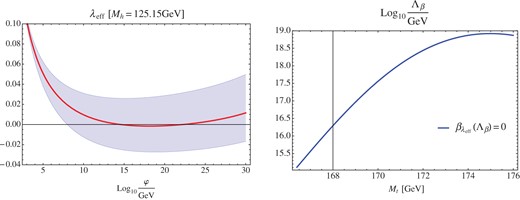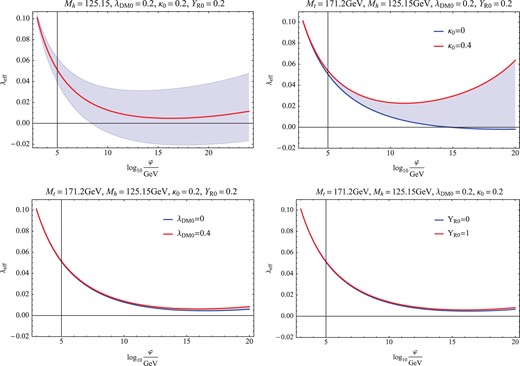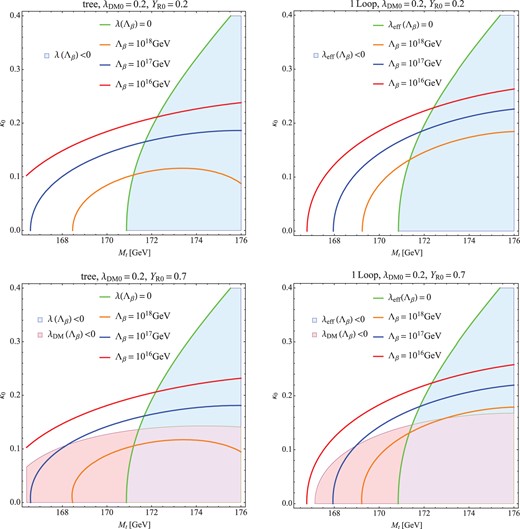Abstract
We consider the multiple point principle of the Standard Model with scalar singlet dark matter (DM) and three heavy right-handed neutrinos at the scale where the beta function |$\beta _{\lambda }$| of the effective Higgs self-coupling |$\lambda _{\rm eff}$| becomes zero. We do a two-loop analysis and find that the top quark mass |$M_{t}$| and the Higgs portal coupling |$\kappa$| are strongly related to each other. One of the good points of this model is that a larger |$M_{t}({\gtrsim }171\,{\rm GeV})$| is allowed. This fact is consistent with the recent experimental value |$M_{t}=173.34 \pm 0.76$|GeV [ATLAS, CDF, CMS, and D0 Collaborations, arXiv:1403.4427 [hep-ex]], which corresponds to the DM mass |$769\,{\rm GeV}\leq m_{\rm DM} \leq 1053$| GeV.
1. Introduction
The discovery of the Higgs-like particle and its mass [1, 2] is a very meaningful result for the Standard Model (SM). It suggests that the Higgs potential can be stable up to the Planck scale |$M_{\rm pl}$| and also that both the Higgs self-coupling |$\lambda$| and its beta function |$\beta _{\lambda }$| become very small around the Planck scale. This fact has attracted much attention, and there are many works trying to find its physical meaning [3–20].
One interesting and meaningful study is to consider how the physics beyond the SM affects such a criticality. For example, recently there has been a two-loop analysis of the Higgs portal |$Z_{2}$| scalar model [21]. In this model, the SM singlet scalar is a dark matter (DM) candidate, and it is found that its mass can be predicted to be |$400\,{\rm GeV} \lt m_{\rm DM} \lt 470\,{\rm GeV}$| from the requirement that |$\lambda$| and |$\beta _{\lambda }$| simultaneously become zero at |$10^{17}$|GeV; this is usually called the multiple point principle (MPP) [3–5].
In this paper, we study the MPP of the next minimal extension of the SM, namely, besides the Higgs portal
|$Z_{2}$| scalar, we include SM singlet heavy right-handed neutrinos [
19,
22,
23]. The MPP of this model at the (reduced) Planck scale
|$M_{{\rm pl}}$| has already been investigated in Ref. [
19]. There, by using the two-loop beta functions and the tree-level Higgs potential, they concluded that
|$m_{{\rm DM}}$| and the heavy Majorana mass
|$M_{\rm R}$| of the right-handed neutrino should be
within |$172.6\,{\rm GeV}\leq M_{t}\leq 174.1\,{\rm GeV}$|. The different points in this paper are as follows:
Although, within the renormalizable Lagrangian, there are also two scalar couplings in this model (see Eq. (12)), we focus on |$\lambda$| (and |$\beta _{\lambda }$|) in this paper.1 The existence of heavy right-handed neutrinos is naturally needed if we try to explain the light neutrino masses by the seesaw mechanism. Thus, this model is phenomenologically interesting because it can explain both DM and the light neutrino masses.
We consider the MPP at the scale where |$\beta _{\lambda }$| becomes zero. Namely, we do not fix the MPP scale at |$M_{{\rm pl}}$|. As a result, the condition |$\beta _{\lambda }=0$| does not reduce the degrees of freedom of the parameters.
In addition to the two-loop beta functions, we also calculate the one-loop effective potential.
We fix |$M_{\rm R}$| to |$10^{13}$|GeV, and include the Yukawa coupling |$Y_{\rm R}$| between the |$Z_{2}$| scalar and the right-handed neutrinos.
This paper is organized as follows. In Sect. 2, we review the MPP of the pure SM for the later discussion. In Sect. 3, we give a two-loop analysis of the SM with the scalar singlet DM and three right-handed neutrinos. In Sect. 4, a summary is given.
2. Preliminary: Multiple point principle of SM
In the SM, the one-loop effective potential in the Landau gauge is given by
where
Here,
|$\mu$| is the renormalization scale,
|$\Gamma (\phi )$| is the wave function renormalization, and
|$\lambda (\mu )$|,
|$y_{t}(\mu )$|,
|$g_{2}(\mu )$|, and
|$g_{Y}(\mu )$| are the renormalized couplings.
2 By using these results, the effective Higgs self-coupling
|$\lambda _{{\rm eff}}(\phi ,\mu )$| can be defined as
To minimize the contribution of
|$V^{{\rm SM}}_{{\rm 1\,loop}}(\phi ,\mu )$|, we set
|$\phi =\mu$| in the following discussion.
The left panel of Fig.
1 shows
|$\lambda _{{\rm eff}}(\phi )$| as a function of
|$\phi$|. For the initial values, we have used the numerical results of Ref. [
24], and the Higgs mass is fixed at
We use Eq. (
8) as a typical value in the following discussion. The band corresponds to
|$95{\%}$| CL deviation of the top quark pole mass
|$M_{t}$|. For the 1
|$\sigma$| level, this is given by [
25]
If we assume that all the other parameters of the SM except for
|$M_{t}$| are fixed, we can find the scale
|$\Lambda _{\beta }$| where
|$\beta _{\lambda _{{\rm eff}}}$| becomes zero as a function of
|$M_{t}$|. Here,
|$\beta _{\lambda _{{\rm eff}}}$| means
The right panel of Fig.
1 shows
|$\Lambda _{\beta }$| as a function of
|$M_{t}$|. The MPP requires that
|$\lambda _{{\rm eff}}(\Lambda _{\beta })$| should become zero, and predicts
This is the MPP of the pure SM. In the next section, we discuss the MPP of the SM with the scalar singlet DM and three right-handed neutrinos.

Fig. 1.
Left: the running effective Higgs self-coupling |$\lambda _{{\rm eff}}$| as a function of the Higgs field |$\phi$|. The blue band corresponds to |$95{\%}$| confidence level (CL) deviation of the top quark pole mass |$M_{t}$|. Right: the scale |$\Lambda _{\beta }$| where |$\beta _{\lambda _{{\rm eff}}}$| becomes zero as a function of |$M_{t}$|.
3. MPP of the SM with scalar singlet dark matter and right-handed neutrinos
We consider the following renormalizable Lagrangian:
Here,
|$H$| is the Higgs field,
|$S$| is the SM singlet real scalar field,
|$m_{{\rm DM}}$| is its mass,
|$\nu _{{\rm R}i}$| are right-handed neutrinos,
|$M_{{\rm R}ij}$| are their Majorana masses, and
|$(Y_{{\rm R}ij},y_{\nu ij})$| are the Yukawa couplings. For simplicity, we assume that
|$M_{{\rm R}ij}$|,
|$Y_{{\rm R}ij}$|, and
|$y_{\nu ij}$| are diagonalized, and also that they are respectively equal for the three generations. In this case, Eq. (
12) becomes
Thus, including the top mass
|$M_{t}$|, there are seven unknown parameters,
in this model. In the following discussion, to distinguish the initial values of these parameters at
|$\mu =M_{t}$| from their running couplings, we use the subscript 0 for their initial values, like
|$\kappa _{0}$|, except for
|$M_{t}$|. Because
|$S$| is the candidate for the DM,
|$m_{{\rm DM}}$| and
|$\kappa$| must satisfy some relation such that they can explain the observed energy density [
27]:
For
|$m_{{\rm DM}}\gtrsim M_{h}$|, this relation is approximately given by [
28]
Moreover, if we assume that the neutrino mass is
|$0.1$| eV,
|$y_{\nu }$| and
|$M_{\rm R}$| must satisfy
where
|$v_{h}$| is the Higgs expectation value. This is the usual relation of the seesaw mechanism. In the following discussion, we choose
|$M_{\rm R}=10^{13}$|GeV, so
|$y_{\nu }$| is fixed by Eq. (
17). As a result, four of the seven parameters remain free; they are
To discuss how the effective couplings behave at the high-energy scale, we must know the renormalization group equations (RGEs) of this model. Their results are presented in Appendix A. Here, note that the contributions from the heavy right-handed neutrinos should be taken into account at the scale where
|$\mu \geq M_{\rm R}$|. The one-loop effective potential of the Higgs field is given by
where
In these expressions, we have put
|$S=0$| because we now focus on the MPP of the Higgs sector.
3 Furthermore, we can neglect
|$m_{{\rm DM}}$| in Eq. (
20) because its effect is very small when
|$\phi \gg m_{{\rm DM}}$|. As in Sect. 2, we set
|$\phi =\mu$|, and define the effective Higgs self-coupling
|$\lambda _{{\rm eff}}$| as
Figure
2 shows
|$\lambda _{{\rm eff}}(\phi )$| for various values of the parameters. Here, the typical values are chosen to be
One can see that
|$\lambda _{{\rm eff}}$| depends mainly on
|$M_{t}$| and
|$\kappa _{0}$|, and hardly on
|$\lambda _{{\rm DM}0}$| and
|$Y_{\rm R0}$|. This is because
|$\lambda _{{\rm DM}}$| does not appear in
|$\beta _{\lambda }$| and
|$Y_{\rm R}$| appears at the two-loop level (see Eq. (
A7) in Appendix A). Therefore, by fixing
|$\lambda _{{\rm DM}}$| and
|$Y_{\rm R}$|, we can relate
|$M_{t}$| and
|$\kappa _{0}$| from the MPP.

Fig. 2.
The running effective Higgs self-coupling |$\lambda _{{\rm eff}}$| as a function of |$\phi$|. The upper left (right) panel shows the |$M_{t}\,(\kappa _{0})$| dependence. For |$M_{t}$|, the blue band corresponds to 95|${\%}$| CL deviation from |$171.2$|GeV. The lower left (right) panel shows the |$\lambda _{{\rm DM}0}$||$(Y_{\rm R0})$| dependence.
By the same procedure of Sect. 2, we can calculate the scale
|$\Lambda _{\beta }$| where
|$\beta _{\lambda _{{\rm eff}}}$| becomes zero, and obtain
|$\lambda _{{\rm eff}}(\Lambda _{\beta })$| as a function of
|$M_{t}$| and
|$\kappa _{0}$|. Figure
3 shows the results. In the upper (lower) panels,
|$Y_{\rm R0}$| is fixed to
|$0.2$||$(0.7)$|. The difference between the left and right panels is whether the tree- or one-loop-level potential is used. The parameter regions where
|$\lambda _{{\rm eff}}(\Lambda _{\beta })\lt 0$| and
|$\lambda _{{\rm DM}}(\Lambda _{\beta })\lt 0$| are filled, respectively, with blue and red. Both of them are excluded from the stability of the potentials. The MPP predicts that
|$M_{t}$| and
|$\kappa _{0}$| should exist on the green contour. One of the good points of this model is that a larger
|$M_{t}$| is allowed, unlike in the SM. This is consistent with the recent experimental value [
26],
which corresponds to the DM mass (see Eq. (
16)),
Two comments are needed.
The contours that represent |$\Lambda _{\beta }=10^{16}$|GeV, |$10^{17}$|GeV, and |$10^{18}$|GeV are also shown in Fig. 3 by red, blue, and orange, respectively. Thus, a larger |$M_{t}$| (such as Eq. (23)) means that, in this model, the MPP of the Higgs potential occurs at the relatively low-energy scale (|${\lesssim }10^{16}$|GeV).
As is seen from the lower panels of Fig. 3, we can also require |$\lambda _{{\rm DM}}(\Lambda _{\beta })=0$| in addition to |$\lambda _{{\rm eff}}(\lambda _{\beta })=0$|. Because |$\kappa _{0}$| and |$Y_{\rm R0}$| appear in the one-loop part of |$\beta _{\lambda _{{\rm DM}}}$|, we can obtain a further relation between them by |$\lambda _{{\rm DM}}(\Lambda _{\beta })=0$|. Although one might think that the one remaining parameter can be determined by |$\beta _{\lambda _{{\rm DM}}}(\Lambda _{\beta })=0$|, we have checked that it is difficult to satisfy |$\lambda _{{\rm DM}}(\Lambda _{\beta }) = \beta _{\lambda _{{\rm DM}}}(\Lambda _{\beta })=0$| simultaneously. See Appendix B for more details.

Fig. 3.
The parameter dependences of |$\lambda _{{\rm eff}}(\Lambda _{\beta })$|. Here, |$\lambda _{{\rm DM}0}$| is fixed at 0.2, and |$Y_{\rm R0}$| is fixed at |$0.2~(0.7)$| in the upper (lower) panels. The left (right) panels show the calculations by using the tree- (one-loop-) level potential. The green lines show the prediction by the MPP. The contours that represent |$\Lambda _{\beta }=10^{16}$|GeV, |$10^{17}$|GeV, and |$10^{18}$|GeV are also shown by red, blue, and orange, respectively.
4. Summary
We have discussed the MPP of the SM with scalar singlet DM and right-handed neutrinos. We have found that
|$\lambda _{{\rm eff}}$| and
|$\beta _{\lambda _{{\rm eff}}}$| can simultaneously become zero within a reasonable parameter region. The MPP predicts a strong relation between the portal coupling
|$\kappa$| and the top mass
|$M_{t}$|. Unlike the pure SM, a larger
|$M_{t}$| is allowed in this model, which is favorable for the recent experimental values [
25,
26]:
Although we have found that the MPP can be satisfied for the Higgs potential, it is difficult to realize the exact flatness of the scalar potential at some high-energy scale
|$\Lambda$|:
see Appendix B for details. It would be interesting to consider a generalization of this model in such a way that the MPP can be realized for whole scalar fields.
Funding
Open Access funding: SCOAP3.
Acknowledgements
We thank Hikaru Kawai, Yuta Hamada, and Koji Tsumura for valuable discussions.
Appendix A. Two-loop renormalization group equations
The two-loop RGEs where the Lagrangian is given by Eq. (
13) are as follows:
4Appendix B. Is an exact flat potential possible?
One question is whether the MPP can be realized exactly, namely, if
is possible or not. Here, for simplicity, we also define
|$\Lambda _{\beta }$| as the scale where
|$\beta _{\lambda }$| becomes zero. To discuss this possibility, it is qualitatively enough to consider one-loop RGEs. One can easily understand that it is impossible to realize Eq. (
B1) as follows: even if
|$\lambda (\Lambda _{\beta })$|,
|$\beta _{\lambda }(\Lambda _{\beta })$|,
|$\lambda _{{\rm DM}}(\Lambda _{\beta })$|, and
|$\beta _{\lambda _{{\rm DM}}}(\Lambda _{\beta })$| become simultaneously zero, we cannot make
|$\kappa (\Lambda _{\beta })$| zero because the one-loop part of
|$\beta _{\lambda _{{\rm DM}}}$| at
|$\Lambda _{\beta }$| becomes
and we need
|$\kappa (\Lambda _{\beta })\neq 0$| to satisfy
|$\beta _{\lambda _{{\rm DM}}}(\Lambda _{\beta })=0$|.
5 Furthermore, it is also difficult even to satisfy
|$\lambda _{{\rm DM}}(\Lambda _{\beta })=\beta _{\lambda _{{\rm DM}}}(\Lambda _{\beta })=0$| simultaneously; see Fig.
B1. This shows the contours such that
|$\lambda _{{\rm DM}}(\Lambda _{\beta })$| and
|$\beta _{\lambda _{{\rm DM}}}(\Lambda _{\beta })$| become zero, respectively. Here, we have used two-loop RGEs. One can see that the two contours do not intersect.

Fig. B1.
The blue (red) lines show the contours where |$\beta _{\lambda _{{\rm DM}}}(\lambda _{{\rm DM}})(\Lambda _{\beta })=0$|. The left (right) panel is the |$M_{t}=170~(176)$|GeV case. Here, note that, if |$\kappa _{0}\gtrsim 0.3$|, |$\Lambda _{\beta }$| becomes less than |$M_{\rm R}=10^{13}$|GeV, and there is no solution of |$\beta _{\lambda _{{\rm DM}}}(\Lambda _{\beta })=0$| because the one-loop part of |$\beta _{\lambda _{{\rm DM}}}$| is always positive when |$\mu \leq M_{\rm R}$|.
References
1et al.
[ATLAS Collaboration]
,
Phys. Lett. B
716
,
1
(
2012
) [
] [].
2et al.
[CMS Collaboration]
,
Phys. Lett. B
716
,
30
(
2012
) [
] [].
3 ,
Phys. Lett. B
368
,
96
(
1996
) [
] [].
4 ,
Phys. Rev. D
64
,
113014
(
2001
) [
] [].
6 ,
Phys. Lett. B
683
,
196
(
2010
) [
] [].
7 ,
Phys. Lett. B
660
,
260
(
2008
) [
] [].
8 ,
J. High Energy Phys.
1408
,
026
(
2014
) [
] [].
9 ,
Prog. Theor. Phys.
127
,
689
(
2012
) [
] [].
10,
Int. J. Mod. Phys. A
28
,
1340001
(
2013
).
11 ,
Int. J. Mod. Phys. A
29
,
1450099
(
2014
) [
] [].
13 ,
Prog. Theor. Exp. Phys.
2014
,
023B02
(
2014
) [
] [].
14 ,
Phys. Rev. Lett.
112
,
241301
(
2014
) [
] [].
17,
Prog. Theor. Exp. Phys.
2013
,
113B04
(
2013
) [
] [].
18 ,
Phys. Lett. B
648
,
312
(
2007
) [
] [].
19 ,
Phys. Rev. D
90
,
036006
(
2014
) [
] [].
20 ,
Prog. Theor. Exp. Phys.
2013
,
023B08
(
2013
) [
] [].
21 ,
J. High Energy Phys.
1407
,
026
(
2014
) [
] [].
22 ,
Phys. Rev. D
89
,
115009
(
2014
) [
] [].
24 ,
J. High Energy Phys.
1312
,
089
(
2013
) [
] [].
26ATLAS, CDF, CMS, and D0 Collaborations
, [
] [].
27et al.
[Planck Collaboration]
,
Astron. Astrophys.
(
2014
) [
] [].
28 ,
Phys. Rev. D
88
,
055025
(
2013
) [
] [].
29 ,
Phys. Rev. D
87
,
053009
(
2013
) [
] [].
30 ,
Nucl. Phys. B
222
,
83
(
1983
).
31 ,
Nucl. Phys. B
236
,
221
(
1984
).
32 ,
Nucl. Phys. B
249
,
70
(
1985
).
© The Author(s) 2015. Published by Oxford University Press on behalf of the Physical Society of Japan.
This is an Open Access article distributed under the terms of the Creative Commons Attribution License (http://creativecommons.org/licenses/by/4.0/), which permits unrestricted use, distribution, and reproduction in any medium, provided the original work is properly cited.Funded by SCOAP3
PDF







